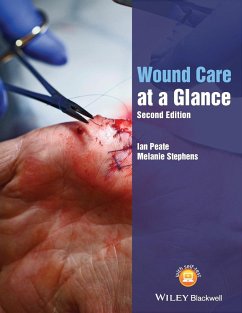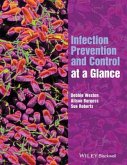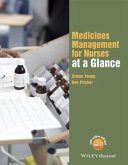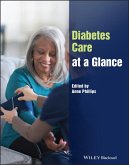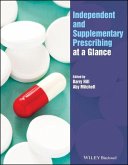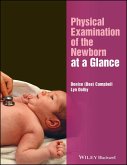Ian Peate (Gibraltar Gibraltar Health Authority), Melanie Stephens (University of Salford, England, UK)
Wound Care at a Glance
Andere Kunden interessierten sich auch für
![Infection Prevention and Control at a Glance Infection Prevention and Control at a Glance]() Debbie Weston (East Kent Hospitals NHS Trust, Kent, UK)Infection Prevention and Control at a Glance46,99 €
Debbie Weston (East Kent Hospitals NHS Trust, Kent, UK)Infection Prevention and Control at a Glance46,99 €![Nursing and Healthcare Research at a Glance Nursing and Healthcare Research at a Glance]() Nursing and Healthcare Research at a Glance45,99 €
Nursing and Healthcare Research at a Glance45,99 €![Medicines Management for Nurses at a Glance Medicines Management for Nurses at a Glance]() Simon Young (University of South Wales)Medicines Management for Nurses at a Glance46,99 €
Simon Young (University of South Wales)Medicines Management for Nurses at a Glance46,99 €![Children and Young People's Nursing Skills at a Glance Children and Young People's Nursing Skills at a Glance]() Children and Young People's Nursing Skills at a Glance53,99 €
Children and Young People's Nursing Skills at a Glance53,99 €![Diabetes Care at a Glance Diabetes Care at a Glance]() Diabetes Care at a Glance44,99 €
Diabetes Care at a Glance44,99 €![Independent and Supplementary Prescribing At a Glance Independent and Supplementary Prescribing At a Glance]() Independent and Supplementary Prescribing At a Glance44,99 €
Independent and Supplementary Prescribing At a Glance44,99 €![Physical Examination of the Newborn at a Glance Physical Examination of the Newborn at a Glance]() Denise CampbellPhysical Examination of the Newborn at a Glance44,99 €
Denise CampbellPhysical Examination of the Newborn at a Glance44,99 €-
-
-
Produktdetails
- At a Glance (Nursing and Healthcare)
- Verlag: John Wiley and Sons Ltd
- 2 ed
- Seitenzahl: 144
- Erscheinungstermin: 30. Januar 2020
- Englisch
- Abmessung: 280mm x 216mm x 8mm
- Gewicht: 430g
- ISBN-13: 9781119590507
- ISBN-10: 1119590507
- Artikelnr.: 57827512
Hinweis: Dieser Artikel kann nur an eine deutsche Lieferadresse ausgeliefert werden.
- Herstellerkennzeichnung
- Libri GmbH
- Europaallee 1
- 36244 Bad Hersfeld
- gpsr@libri.de
Ian Peate, OBE FRCN is Visiting Professor of Nursing, Visiting Senior Clinical Fellow, Editor-in-Chief of the British Journal of Nursing, and Head of School, School of Health Studies, Gibraltar. Melanie Stephens is Senior Lecturer in Adult Nursing at Salford University, Chairman of the University of Salford International Wound Management Committee, and Module Lead for Tissue Viability and Leg Ulcer Management Modules.
Preface to the second edition vii
Acknowledgements viii
How to use your textbook ix
About the companion website xi
Part 1 Anatomy and physiology 1
1 The history of wound care 2
2 Anatomy and physiology of the skin 4
3 Psychological and social aspects of the skin 6
4 Body image 8
5 The skin and ageing 12
Part 2 The normal healing process: acute wounds 15
6 Haemostasis 16
7 Inflammation 18
8 Proliferation (granulation and epithelialisation) 20
9 Maturation 22
10 Factors affecting wound-healing 24
Part 3 The abnormal healing process: chronic wound healing 27
11 The impaired healing process 28
12 Factors affecting wound-healing 30
13 Nutrition and wound-healing 32
14 Incontinence and wounds 34
15 Vascular disease 36
Part 4 Wound management in practice 39
16 Assessment of skin 40
17 Assessment of the patient with a wound 42
18 Classification of wounds 46
19 Legal and ethical aspects of wound care 48
20 Documenting wounds and keeping records 50
21 Evidence based practice 52
22 Treatment options 54
23 Pain management 56
Part 5 Dressing selection 59
24 Principles of wound management I 60
25 Principles of wound management II 61
26 Managing wound exudate: moist wound healing, hydration and maceration 62
27 Generic wound products: mode of action 64
28 Choosing a wound care product 68
29 Use of topical antimicrobials and antibiotics 70
30 Application of lotions, creams, emollients and ointments 74
31 Advanced technologies 76
Part 6 Complexities of wound care 79
32 Pressure redistribution equipment 80
33 Pressure ulcer classification and prevention 82
34 Pressure ulcers 86
35 Venous leg ulcers 88
36 Lymphoedema 90
37 Compression therapy 92
38 Arterial ulcers 94
39 Assessing for arterial disease: ankle-brachial pressure index and
toe-brachial pressure index 96
40 Interpreting ABPIs 100
41 Diabetic foot ulcers 102
42 Moisture lesions 106
43 Surgical wounds 108
44 Traumatic wounds 112
45 Burns and scalds 114
46 Atypical wounds 116
47 Wounds in different populations 118
48 Malignant wounds and palliative wound care 120
Glossary 124
References and further reading 126
Index 128
Acknowledgements viii
How to use your textbook ix
About the companion website xi
Part 1 Anatomy and physiology 1
1 The history of wound care 2
2 Anatomy and physiology of the skin 4
3 Psychological and social aspects of the skin 6
4 Body image 8
5 The skin and ageing 12
Part 2 The normal healing process: acute wounds 15
6 Haemostasis 16
7 Inflammation 18
8 Proliferation (granulation and epithelialisation) 20
9 Maturation 22
10 Factors affecting wound-healing 24
Part 3 The abnormal healing process: chronic wound healing 27
11 The impaired healing process 28
12 Factors affecting wound-healing 30
13 Nutrition and wound-healing 32
14 Incontinence and wounds 34
15 Vascular disease 36
Part 4 Wound management in practice 39
16 Assessment of skin 40
17 Assessment of the patient with a wound 42
18 Classification of wounds 46
19 Legal and ethical aspects of wound care 48
20 Documenting wounds and keeping records 50
21 Evidence based practice 52
22 Treatment options 54
23 Pain management 56
Part 5 Dressing selection 59
24 Principles of wound management I 60
25 Principles of wound management II 61
26 Managing wound exudate: moist wound healing, hydration and maceration 62
27 Generic wound products: mode of action 64
28 Choosing a wound care product 68
29 Use of topical antimicrobials and antibiotics 70
30 Application of lotions, creams, emollients and ointments 74
31 Advanced technologies 76
Part 6 Complexities of wound care 79
32 Pressure redistribution equipment 80
33 Pressure ulcer classification and prevention 82
34 Pressure ulcers 86
35 Venous leg ulcers 88
36 Lymphoedema 90
37 Compression therapy 92
38 Arterial ulcers 94
39 Assessing for arterial disease: ankle-brachial pressure index and
toe-brachial pressure index 96
40 Interpreting ABPIs 100
41 Diabetic foot ulcers 102
42 Moisture lesions 106
43 Surgical wounds 108
44 Traumatic wounds 112
45 Burns and scalds 114
46 Atypical wounds 116
47 Wounds in different populations 118
48 Malignant wounds and palliative wound care 120
Glossary 124
References and further reading 126
Index 128
Preface to the second edition vii
Acknowledgements viii
How to use your textbook ix
About the companion website xi
Part 1 Anatomy and physiology 1
1 The history of wound care 2
2 Anatomy and physiology of the skin 4
3 Psychological and social aspects of the skin 6
4 Body image 8
5 The skin and ageing 12
Part 2 The normal healing process: acute wounds 15
6 Haemostasis 16
7 Inflammation 18
8 Proliferation (granulation and epithelialisation) 20
9 Maturation 22
10 Factors affecting wound-healing 24
Part 3 The abnormal healing process: chronic wound healing 27
11 The impaired healing process 28
12 Factors affecting wound-healing 30
13 Nutrition and wound-healing 32
14 Incontinence and wounds 34
15 Vascular disease 36
Part 4 Wound management in practice 39
16 Assessment of skin 40
17 Assessment of the patient with a wound 42
18 Classification of wounds 46
19 Legal and ethical aspects of wound care 48
20 Documenting wounds and keeping records 50
21 Evidence based practice 52
22 Treatment options 54
23 Pain management 56
Part 5 Dressing selection 59
24 Principles of wound management I 60
25 Principles of wound management II 61
26 Managing wound exudate: moist wound healing, hydration and maceration 62
27 Generic wound products: mode of action 64
28 Choosing a wound care product 68
29 Use of topical antimicrobials and antibiotics 70
30 Application of lotions, creams, emollients and ointments 74
31 Advanced technologies 76
Part 6 Complexities of wound care 79
32 Pressure redistribution equipment 80
33 Pressure ulcer classification and prevention 82
34 Pressure ulcers 86
35 Venous leg ulcers 88
36 Lymphoedema 90
37 Compression therapy 92
38 Arterial ulcers 94
39 Assessing for arterial disease: ankle-brachial pressure index and
toe-brachial pressure index 96
40 Interpreting ABPIs 100
41 Diabetic foot ulcers 102
42 Moisture lesions 106
43 Surgical wounds 108
44 Traumatic wounds 112
45 Burns and scalds 114
46 Atypical wounds 116
47 Wounds in different populations 118
48 Malignant wounds and palliative wound care 120
Glossary 124
References and further reading 126
Index 128
Acknowledgements viii
How to use your textbook ix
About the companion website xi
Part 1 Anatomy and physiology 1
1 The history of wound care 2
2 Anatomy and physiology of the skin 4
3 Psychological and social aspects of the skin 6
4 Body image 8
5 The skin and ageing 12
Part 2 The normal healing process: acute wounds 15
6 Haemostasis 16
7 Inflammation 18
8 Proliferation (granulation and epithelialisation) 20
9 Maturation 22
10 Factors affecting wound-healing 24
Part 3 The abnormal healing process: chronic wound healing 27
11 The impaired healing process 28
12 Factors affecting wound-healing 30
13 Nutrition and wound-healing 32
14 Incontinence and wounds 34
15 Vascular disease 36
Part 4 Wound management in practice 39
16 Assessment of skin 40
17 Assessment of the patient with a wound 42
18 Classification of wounds 46
19 Legal and ethical aspects of wound care 48
20 Documenting wounds and keeping records 50
21 Evidence based practice 52
22 Treatment options 54
23 Pain management 56
Part 5 Dressing selection 59
24 Principles of wound management I 60
25 Principles of wound management II 61
26 Managing wound exudate: moist wound healing, hydration and maceration 62
27 Generic wound products: mode of action 64
28 Choosing a wound care product 68
29 Use of topical antimicrobials and antibiotics 70
30 Application of lotions, creams, emollients and ointments 74
31 Advanced technologies 76
Part 6 Complexities of wound care 79
32 Pressure redistribution equipment 80
33 Pressure ulcer classification and prevention 82
34 Pressure ulcers 86
35 Venous leg ulcers 88
36 Lymphoedema 90
37 Compression therapy 92
38 Arterial ulcers 94
39 Assessing for arterial disease: ankle-brachial pressure index and
toe-brachial pressure index 96
40 Interpreting ABPIs 100
41 Diabetic foot ulcers 102
42 Moisture lesions 106
43 Surgical wounds 108
44 Traumatic wounds 112
45 Burns and scalds 114
46 Atypical wounds 116
47 Wounds in different populations 118
48 Malignant wounds and palliative wound care 120
Glossary 124
References and further reading 126
Index 128

